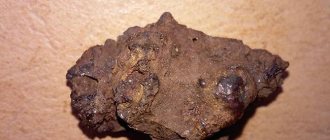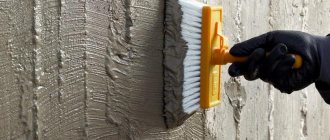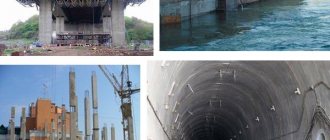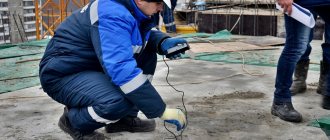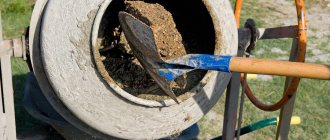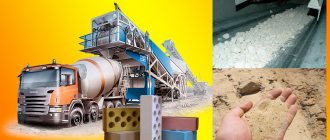The transfer strength of concrete is one of the most important characteristics of hardened stone, which is very important for design and calculations, determining the quality of the finished monolith and its ability to withstand the imposed loads. Concrete is a type of artificial stone that is produced on the basis of cement and various fillers with water in the form of a liquid solution that hardens into a solid monolith.
In order for the mixture to harden correctly and the final technical characteristics of the concrete to be sufficient for use under certain conditions, it is necessary to strictly follow the technology for preparing the concrete mixture and correctly perform all preliminary calculations. The main indicator of the bearing capacity and reliability of concrete is its strength, recorded during various studies and expressed in established values.
All technical characteristics of concrete are usually studied in special laboratories.
, in the process of influencing them by various mechanical methods (impact, chipping, ultrasound, lowering the press, etc.). One of the main indicators of quality is the density of the frozen solution, expressed in the ratio of weight to volume. The density is affected by the volume of entrained air and the curing characteristics of the concrete. The smaller the volume of air, the smaller the number of pores in the structure of the stone and the higher the density and strength.
The relationship between density and strength is direct. Average strength is a mandatory parameter that is taken into account in calculations and directly affects the quality and service life of a structural element or building. If the strength is insufficient, the element quickly becomes covered with cracks and collapses; if it is too strong, the high costs are simply not justified.
The strength class of hardened concrete is indicated by the letter B and numbers, measured in MPa. Also an indicator of strength is the brand of cement or concrete involved in the mixture and the number next to it, displaying the load that concrete can withstand, in kilograms per square centimeter.
Definitions
Cubic strength is the axial compressive (tensile) strength. This characteristic is determined on cubic samples with accepted standard dimensions of 15x15x15 cm. However, sometimes, in the case of very small or, conversely, very large filler, the edges of the cube can have a size of 10 or 20 centimeters. In this case, for testing samples with such dimensions, a correction factor is introduced equal to
- for cubes with a side of 10 cm K≈0.90,
- with a side of 20 cm K≈1.1.
The sample is centered on the press support plate along its geometric axis and is subjected to pressure loading corresponding to a stress increase of 0.3: 0.4 MPa/sec, that is, in the range from 6.75 to 9.0 kN/sec on the scale of measuring force to failure .
The calculation is carried out using a formula that takes into account the tensile strength of each sample \( R=\frac{F}{A_{0}}K \) MPa, in which
- F – load preceding sample failure, expressed in kN;
- A0 is the cross-sectional area of the sample before failure, expressed in cm2;
- K – conversion factors from the tested cubes to the reference cube with a standard edge of 15 cm.
Cubic strength calculations are made based on the arithmetic mean value in series of three or more samples. If the test results of one of the samples differ from the neighboring sample by more than 15%, the sample is rejected. And if the neighboring indicator differs from the next one also in a larger direction and by the same 15%, the entire series of tested samples is rejected.
Near the press support plates (upper and lower), the friction force directed inside the prism between the sample and the plates creates something like two truncated pyramids directed at each other, a cage effect, which increases the compressive strength of the samples (option “a”). Add any lubricant to the supporting planes - and the nature of the destruction will change, the cube will split along planes parallel to the vector of the applied force (option “b”). The thick black stripe in version 2 is lubricant applied to the supporting edges.
However, in reality, the shape of reinforced concrete structures only in rare cases repeats the shape of the tested reference samples. Therefore, in tests and calculations, the prismatic strength Rb is used.
With the “height-to-base” aspect ratio, when the length of the sides of the base is always less than the length of the height of the tested samples, for samples of shapes close to the prism, the load on the bases at the moment of compression is always less than on the edge of the prism in height. This is perfectly demonstrated by practice, when the stress in the compressed zone of concrete products is close to the state of prisms under compression. That is, prisms and forms conventionally close to them will always demonstrate lower compressive strength. If the height of the prism is related to the sides of the base as h/2˃4, the friction force has practically no effect, and the strength value becomes practically unchanged, equal to ≈0.75R.
Prismatic strength Rb is calculated using a similar formula as the quotient of the magnitude of the breaking load divided by the cross-sectional area of the sample.
Graph of the dependence of the prismatic strength of concrete on the ratio of the dimensions of the tested sample
Transfer strength - what is it?
The transfer strength of concrete is the strength of the concrete stone at the time of compression (tension release). This indicator is also very important for prestressed elements, along with the design strength. The actual indicator of transfer strength when meeting production control requirements in accordance with GOST 18105-72 in all cases must be not lower than 14 mPa, with reinforcement ropes of class K-7, rod reinforcement of class AT-VI, wire reinforcement of class VR-P (in the absence of upset heads) – minimum 20 MPa.
In the case where the design grades of concrete are taken above the minimum value, the transfer strength must be at least 50% of the adopted design grade.
Transfer strength is also the cubic strength of the concrete stone at the moment of compression, denoted Rbp. In most cases, it is less than the design strength for class B. After all, waiting for concrete to reach 100% strength takes time and is wasteful in factory production conditions.
Therefore, it is common to specify the minimum Rbp value that will provide sufficient strength and resistance to cracking during crimping, transportation and lifting. It is believed that before the application of operational loads, the concrete monolith will gain the required design strength.
It is worth remembering that the lower the transfer strength, the more serious the creep losses can be, and the compression force also decreases. But the higher the Rbp value, the longer the heat treatment takes and the more expensive the design is. It has been experimentally determined that in most cases the most optimal Rbp value is 0.7V.
Design standards, as a rule, do not include a designation of the transfer prismatic strength of concrete, which is most often taken into account in calculations. In this regard, designers are forced to enter their own letter designations for this technical characteristic.
Test methods
Different construction projects use concrete of different densities and strengths. These indicators may depend not only on the brand of cement, but also on the conditions in which it was stored before its use. That is, a decrease in the astringent properties of cement does not necessarily occur due to the expiration of its shelf life. A drop in quality can also occur due to improper storage conditions. To determine such characteristics of concrete as strength, laboratory and production tests use concrete cubes with a side of 15x15x15 cm, kept for 28 days from the day of casting.
The strength of samples can be tested using two methods: destructive and non-destructive. The essence of the first is to crush such samples, and it is more accurate. Just such a technique includes cubic and prismatic testing of samples, regulated by GOST 18105-2010.
Non-destructive ones include:
- impact tests (one-time extreme and precisely calibrated impact of force. This can be a pneumatic tool with adjustable impact force, as well as a laboratory explosion.);
- testing by partial destruction method - done by tearing off a metal disk glued to the concrete surface being tested, by chipping a concrete sample, or by a combined method - tearing off + chipping;
- ultrasonic influence. When using this method, a calibration relationship is built between the strength of concrete and the speed of ultrasound passing through it.
When determining strength, Poisson's ratio is also taken into account - the initial value of transverse deformation, which for concrete is 0.16. However, this is the value for “ideal” concrete. In practice, taking into account the processes of micro- and macrocrack formation, amendments are made to the coefficient based on the grades of concrete and the types of activities in which the tested concrete products will be used. And this coefficient can range from 0.1 to 0.35.
Determination of concrete strength
According to clause 5.5.5 of SP 70.13330.2012, control of the strength of concrete of monolithic structures at intermediate and design ages should be carried out using statistical methods in accordance with GOST 18105, GOST 31914, using non-destructive methods for determining the strength of concrete in accordance with GOST 17624 and GOST 22690 or a destructive method in accordance with GOST 28570 at continuous strength control (of each structure).
Note - The use of non-statistical control methods , as well as methods for determining the strength of concrete using control samples made at the site of concreting structures, is allowed only in exceptional cases provided for in GOST 18105 and GOST 31914 .
What affects the strength of samples?
The strength of samples depends on several indicators. This:
- brand and quality of cement related to its chemical activity;
- its quantity in the concrete batch;
- the form for filling, as well as its cleanliness (foreign impurities can dramatically deteriorate the quality of concrete);
- thorough mixing, uniformity of the mixture of cement and fillers;
- use of vibrators, that is, compaction conditions;
- age of casting (must be at least 28 days);
- the temperature at which the concrete casting hardened.
A separate question should always be the amount of water that was used to prepare the concrete. The optimal amount should be within 20%, regardless of the ratio of all other components in the concrete mixture.
Product properties control and testing
To determine the described characteristics of the produced material, specialists in factory laboratories use a concrete strength meter. These devices operate on different principles, which are divided into non-destructive and destructive.
Such testing methods are known.
Checking the cube with an ultrasonic concrete scope.
- Non-destructive indirect methods using the shock pulse method, as well as a pulsed ultrasonic analogue.
- Non-destructive direct methods only partially break the sample material. This can be the principle of tearing off with chipping or the corner chipping technique. In this case, force meters are used.
- Destructive methods are divided into inspection of concrete cubes (according to State Standard No. 10180) and destruction of cores removed from structures (according to State Standard No. 28570). In this case, various hydraulic presses are used.
Sample Shape
During material testing, experts identify such categories based on the shape of the samples.
- The cubic strength of concrete is the resistance (temporary) to compression of concrete cubes with dimensions of 20x20x20 cm.
- Prismatic strength is the limit of resistance to compression of concrete prisms with dimensions of 15×15×60 cm or 20×20×
The photo shows the definition of cubic strength.
Note! According to SNiP No. 52/01/2003, the compressive strength class of the mortar is equal to the value of its cube strength with a security of 95%. In other words, regulatory documents define this parameter as the main mechanical property of concrete.
The prismatic value better shows the resistance of the material to compression (beams, columns, etc. are more similar in shape to a prism than a cube). However, prism testing is an expensive and time-consuming process. The cost of testing cubes is less, and the process itself is simpler.
Non-destructive testing procedure
Since it is possible to determine the average strength of concrete using a non-destructive method without special preparation, right on site, using modern electronic devices, we will consider just such a method, which consists of several stages:
- Stage 1. It is necessary to select a smooth edge of the product without cracks, chips or other defects. It is on this that further tests will be carried out.
- Step 2. Depending on the type of device, the following procedure may differ, but the basic principles are the same for any device. Namely, after turning on the sclerometer and selecting the required function, it is necessary to position it in relation to the surface of the concrete product strictly at a right angle, and press the corresponding button.
- Stage 3. The resulting value will be displayed on the screen. The instructions for the device will indicate the total number of times the above operation was performed to obtain the average value.
- Stage 4. If necessary, you can draw up an act of determining the strength of reinforced concrete structures using a non-destructive method, which will have legal force.
Correct placement of the device relative to the surface being tested
After determining the strength of concrete using a non-destructive method is completed, it is necessary to completely turn off the device. A very convenient “gadget” for any foreman, and even a simple craftsman. He definitely won’t “lie” about the quality of concrete at any stage of construction. You just need to remember to constantly check it.
The latest generation of durable compounds
Material with improved qualities makes it possible to construct mega-buildings.
Typically, the M500 grade is used as durable concrete, but there is also demand for analogues, up to M-1000. Moreover, modern construction technologies are in dire need of even higher quality materials.
As a result, specialists have developed a new generation of heavy-duty concrete, brand M-1500. To mix it, 1.5/2 times less binder is required than using traditional technology.
In this case, the characteristics of the materials will be equal. This high-strength concrete can be produced in a conventional plant.
